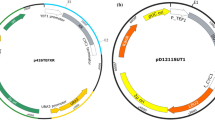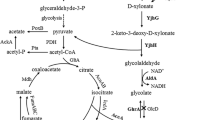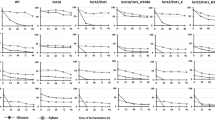Abstract
Efficient bioconversion of d-xylose into various biochemicals is critical for the developing lignocelluloses application. In this study, we compared d-xylose utilization in Candida glycerinogenes WL2002-5 transformants expressing xylose reductase (XYL1) in d-xylose metabolism. C. glycerinogenes WL2002-5 expressing XYL1 from Schefferomyces stipitis can produce xylitol. Xylitol production by the recombinant strains was evaluated using a xylitol fermentation medium with glucose as a co-substrate. As glucose was found to be an insufficient co-substrate, various carbon sources were screened for efficient cofactor regeneration, and glycerol was found to be the best co-substrate. The effects of glycerol on the xylitol production rate by a xylose reductase gene (XYL1)-overexpressed mutant of C. glycerinogenes WL2002-5 were investigated. The XYL1-overexpressed mutant produced xylitol from d-xylose using glycerol as a co-substrate for cell growth and NAD (P) H regeneration: 100 g/L d-xylose was completely converted into xylitol when at least 20 g/L glycerol was used as a co-substrate. XYL1 overexpressed mutant grown on glycerol as co-substrate accumulated 2.1-fold increased xylitol concentration over those cells grown on glucose as co-substrate. XYL1 overexpressed mutant produced xylitol with a volumetric productivity of 0.83 g/L/h, and a xylitol yield of 98 % xylose. Recombinant yeast strains obtained in this study are promising candidates for xylitol production. This is the first report of XYL1 gene overexpression of C. glycerinogenes WL2002-5 for enhancing the efficiency of xylitol production.









Similar content being viewed by others
References
Hahn-Hagerdal, B., Galbe, M., Gorwa-Grauslund, M. F., Lidén, G., & Zacchi, G. (2006). Bioethanol—the fuel of tomorrow from the residues of today. Trends in Biotechnology, 24, 549–556.
Ragauskas, A. J., Williams, C. K., Davison, B. H., Britovsek, G., Cairney, J., Eckert, C. A., Frederick, W. J., Hallett, J. P., Leak, D. J., Liotta, C. L., Mielenz, J. R., Murphy, R., Templer, R., & Tschaplinski, T. (2006). The path forward for biofuels and biomaterials. Science, 311, 484–489.
Zhang, W., & Geng, A. L. (2012). Improved ethanol production by a xylose fermenting recombinant yeast strain constructed through a modified genome shuffling method. Biotechnology for Biofuels, 5, 46.
Jeffries, T. W., & Jin, Y. S. (2004). Metabolic engineering for improved fermentation of pentoses by yeasts. Applied Microbiology and Biotechnology, 63, 495–509.
Guo, X. X., Zhang, R. H., Li, Z., Dai, D. Z., Li, C., & Zhou, X. H. (2013). A novel pathway construction in Candida tropicalis for direct xylitol conversion from corncob xylan. Bioresource Technology, 128, 547–552.
Kumar, S., Singh, S. P., Mishra, I. M., & Adhikari, D. K. (2009). Ethanol and xylitol production from glucose and xylose at high temperature by Kluyveromyces sp IIPE453. Journal of Industrial Microbiology & Biotechnology, 36, 1483–1489.
Sasaki, M., Jojima, T., Inui, M., & Yukawa, H. (2010). Xylitol production by recombinant Corynebacterium glutamicum under oxygen deprivation. Applied Microbiology and Biotechnology, 86, 1057–1066.
Pasha, C., Kuhad, R. C., & Venkateswar, R. L. (2007). Stain improvement of thermotolerant Saccharomyces cerevisiae VS3 strain for better utilization of lignocellulosic substrates. Journal of Applied Microbiology, 103, 1480–1489.
Zhuge, J., Fang, H. Y., Wang, Z. X., Chen, D. Z., Jin, H. R., & Gu, H. L. (2001). Glycerol production by a novel osmotolerant yeast Candida glycerinogenes. Applied Microbiology and Biotechnology, 55, 686–692.
Wang, Z. X., Zhuge, J., Fang, H., & Prior, B. A. (2001). Glycerol production by microbial fermentation: a review. Biotechnology Advances, 19, 201–223.
Jin, H. R., Fang, H. Y., & Zhuge, J. (2003). By-product formation by a novel glycerol-producing yeast, Candida glycerinogenes, with different O2 supplies. Biotechnology Letters, 25, 311–314.
Xie, T., Fang, H. Y., Zhuge, B., & Zhuge, J. (2009). Promotional mechanism of high glycerol productivity in the aerobic batch fermentation of Candida glycerinogenes after feeding several amino acids. Applied Biochemistry and Microbiology, 45, 303–308.
Zhao, L., Zhang, X., & Tan, T. (2008). Influence of various glucose/xylose mixtures on ethanol production by Pachysolen tannophilus. Biomass and Bioenergy, 32, 1156–1161.
Joshua, S. Y., Jason, B., Nathan, R. S., Ayalew, M., & CNeal, S., Jr. (2007). Statistical tools for transgene copy number estimation based on real-time PCR. BMC Bioinformatics, 8, S6.
Matsushika, A., Inoue, H., Kodaki, T., & Sawayama, S. (2009). Ethanol production from xylose in engineered Saccharomyces cerevisiae strains: current state and perspectives. Applied Microbiology and Biotechnology, 84, 37–53.
Ko, B. S., Kim, J., & Kim, J. H. (2006). Production of xylitol from D-xylose by a xylitol dehydrogenase gene-disrupted mutant of Candida tropicalis. Applied and Environmental Microbiology, 72, 4207–4213.
Ko, B. S., Rhee, C. H., & Kim, J. H. (2006). Enhancement of xylitol productivity and yield using a xylitol dehydrogenase gene-disrupted mutant of Candida tropicalis under fully aerobic conditions. Biotechnology Letters, 28, 1159–1162.
Zhang, C., Zong, H., Zhuge, B., Lu, X. Y., Fang, H. Y., & Zhuge, J. (2015). Integrative expression vectors for overexpression of xylitol dehydrogenase (XYL2) in osmotolerant yeast, Candida glycerinogenes WL2002-5. Journal of Industrial Microbiology & Biotechnology, 42, 113–124.
Chen, X. Z., Fang, H. Y., Rao, Z. M., Shen, W., Zhuge, B., Wang, Z. X., & Zhuge, J. (2008). Cloning and characterization of a NAD+-dependent glycerol-3-phosphate dehydrogenase gene from Candida glycerinogenes, an industrial glycerol producer. FEMS Yeast Research, 8, 725–734.
Ponchel, F. (2003). Real-time PCR based on SYBR-Green I fluorescence: an alternative to the TaqMan assay for a relative quantification of gene rearrangements, gene amplifications and micro gene deletions. BMC Biotechnology, 3, 18.
Hernandez, M., Esteve, T., Prat, S., & Pla, M. (2004). Development of realtime PCR systems based on SYBR Green I, Amplifluor and TaqMan technologies for specific quantitative detection of the transgenic maize event GA21. Journal of Cereal Science, 39, 99–107.
Grace, Q. C., & Jiann-Tsyh, L. (2010). Use of quantitative polymerase chain reaction for determining copy numbers of transgenes in Lesquerella fendleri. American Journal of Agricultural Economics, 5, 415–421.
Zhang, C., Zhuge, B., Zhan, X. B., Fang, H. Y., Zong, H., & Zhuge, J. (2013). Cloning and characterization of a novel NAD+-dependent glyceraldehyde-3-phosphate dehydrogenasegene from Candida glycerinogenes and use of its promoter. Yeast, 30, 157–163.
Ballester, M., Castelló, A., Ibáñez, E., Sánchez, A., & Folch, J. M. (2004). Real-time quantitative PCR-based system for determining transgene copy number in transgenic animals. Biotechnology Techniques, 37, 610–613.
Molishree, U. J., Keith, H. P., Carl, E. H., & Kathryn, M. V. (2008). Real-time PCR to determine transgene copy number and to quantitate the biolocalization of adoptively transferred cells from EGFP-transgenic mice. Biotechnology Techniques, 45, 247–258.
Eliasson, A., Christensson, C., Wahlbom, C. F., & Hahn-Hagerdal, B. (2000). Anaerobic xylose fermentation by recombinant Saccharomyces cerevisiae carrying XYL1, XYL2, and XKS1 in mineral medium chemostat cultures. Applied and Environmental Microbiology, 66, 3381–3386.
Wang, M., Fu, J., Zhang, X., & Chen, T. (2012). Metabolic engineering of Bacillus subtilis for enhanced production of acetoin. Biotechnology Letters, 34, 1877–1885.
Meiswinkel, T. M., Gopinath, V., Lindner, S. N., Nampoothiri, K. M., & Wendisch, V. F. (2013). Accelerated pentose utilization by Corynebacterium glutamicum for accelerated production of lysine, glutamate, ornithine and putrescine. Microbial Biotechnology, 6, 131–140.
Laemmli, U. K. (1970). Cleavage of structural proteins during the assembly of the head of bacteriophage T4. Nature, 227, 680–685.
Yeung, P., Ding, L., & Casley, W. L. (2008). HPLC assay with UV detection for determination of RBC purine nucleotide concentrations and application for biomarker study in vivo. Journal of Pharmaceutical and Biomedical, 47, 377–382.
Sato, K., Yoshida, Y., Hirahara, T., & Ohba, T. (2000). On-line measurement of intracellular ATP of Saccharomyces cerevisiae and pyruvate during sake mashing. Journal of Bioscience and Bioengineering, 90, 294–301.
Kleinzeller, A., & Kotyk, A. (1967). Transport of monosaccharides in yeast cells and its relationship to cell metabolism. In A. K. Mills & H. Krebs (Eds.), Aspects of yeast metabolism (pp. 33–45). Philadelphia: F. A. Davis Co.
Kotyk, A. (1967). Properties of the sugar carrier in baker’s yeast. II. Specificity of transport. Folia Microbiologica, 12, 121–131.
Cirillo, V. P. (1968). Relationship between sugar structure and competition for the sugar transport system in baker’s yeast. Journal of Bacteriology, 95, 603–611.
Bisson, L. F., Neigeborn, L., Carlson, M., & Fraenkel, D. G. (1987). The SNF3 gene is required for high-affinity glucose transport in Saccharomyces cerevisiae. Journal of Bacteriology, 169, 1656–1662.
Busturia, A., & Lagunas, R. (1986). Catabolite inactivation of the glucose transport system in Saccharomyces cerevisiae. Journal of General Microbiology, 132, 379–385.
Serrano, R., & Delafuente, G. (1974). Regulatory properties of the constitutive hexose transport in Saccharomyces cerevisiae. Molecular and Cellular Biochemistry, 5, 161–171.
Vall, Z. C., Prior, B. A., Kilian, S. Q., & Brandt, E. V. (1993). Role of D-ribose cometabolite in D-xylose metabolism by Saccharomyces cerevisiae. Applied and Environmental Microbiology, 59, 1487–1494.
Bruinenberg, P. M., Van, D. J. P., & Scheffers, W. A. (1983). A theoretical analysis of NADPH production and consumption in yeasts. Journal of General Microbiology, 129, 953–964.
Peng, B., Shen, Y., Li, X., Chen, X., Hou, J., & Bao, X. (2012). Improvement of xylose fermentation in respiratory-deficient xylose-fermenting Saccharomyces cerevisiae. Metabolic Engineering, 14, 9–18.
Parachin, N. S., Bergdahl, B., van Niel, E. W. J., & Gorwa-Grauslund, M. F. (2011). Kinetic modelling reveals current limitations in the production of ethanol from xylose by recombinant Saccharomyces cerevisiae. Metabolic Engineering, 13, 508–517.
Young, E. M., Poucher, A., Comer, A., Bailey, A., & Alper, H. S. (2011). Functional survey for heterologous sugar transport proteins, using Saccharomyces cerevisiae as a host. Applied and Environmental Microbiology, 77, 3311–3319.
Chung, Y. S., Kim, M. D., Lee, W. J., Ryu, Y. W., Kim, J. H., & Seo, J. H. (2002). Stable expression of xylose reductase gene enhances xylitol production in recombinant Saccharomyces cerevisiae. Enzyme and Microbial Technology, 30, 809–816.
Kwon, D. H., Kim, M. D., Lee, T. H., Oh, Y. J., Ryu, Y. W., & Seo, J. H. (2006). Elevation of glucose 6-phosphate dehydrogenase activity increases xylitol production in recombinant Saccharomyces cerevisiae. Journal of Molecular Catalysis B: Enzymatic, 43, 86–89.
Acknowledgments
This work was funded by China National “863” High-Tech Program (No. 2012AA021201, No. 2011AA02A207) and supported by the National Natural Science Foundation of China (No. 31270080) and Jiangnan University Independent Scientific Research Programs (No. JUSRP1008, No. JUSRP11431), the Natural Science Foundation of Jiangsu province (No. BK20140134, No. BK20140138) and Six talent peaks project in Jiangsu Province (NO. 2014-XCL-017).
Author information
Authors and Affiliations
Corresponding author
Rights and permissions
About this article
Cite this article
Zhang, C., Zong, H., Zhuge, B. et al. Production of Xylitol from d-Xylose by Overexpression of Xylose Reductase in Osmotolerant Yeast Candida glycerinogenes WL2002-5. Appl Biochem Biotechnol 176, 1511–1527 (2015). https://doi.org/10.1007/s12010-015-1661-8
Received:
Accepted:
Published:
Issue Date:
DOI: https://doi.org/10.1007/s12010-015-1661-8




